初中英语:英语中的倒装句(共15张PPT)
合集下载
初中英语英语中的倒装句ppt课件
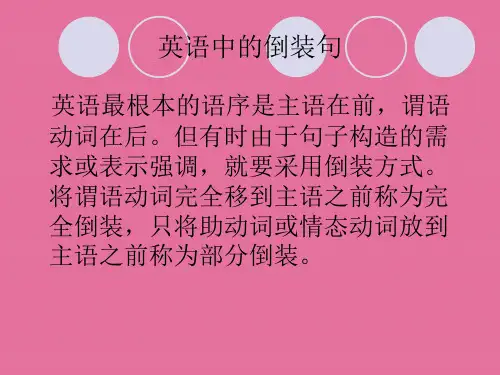
1〕 Young as/though she was, she could work out that problem alone. 虽然她很小,但她却能单独解出那道难题。
2〕Child as/though he is, he is very brave. 虽然他是个孩子,但他却非常英勇。
留意:假设从句中的表语是名词,其名词前不加任何冠词。
1〕Out rushed the soldiers. 战士们冲了出去。
2〕Away went the boy. 那男孩走开了。
请比较: 3〕Away he went.他走开了。 4〕Here he comes.他来了。
4.为了坚持句子平衡,强调表语和状语,使句子上下严密衔接。如:
1〕At the entrance of the valley stood an old pine tree. 在峡谷的入口处屹立着一棵古老的松柏。
英语中的倒装句
英语最根本的语序是主语在前,谓语 动词在后。但有时由于句子构造的需 求或表示强调,就要采用倒装方式。 将谓语动词完全移到主语之前称为完 全倒装,只将助动词或情态动词放到 主语之前称为部分倒装。
一、几种常见的部分倒装构造: 1.Only+状语或者状语从句放在句首。如: Only in this way can we improve our English.
2〕So hard does he work that he has no time to spare for travelling. 他那么努力任务,抽不出时间去游览。
6.虚拟条件句省略if时,将were,should或had移到主语之前。如: 1〕Should it rain,all the crops would be saved. 假设是下雨的话,庄稼就都得救了。
2〕Child as/though he is, he is very brave. 虽然他是个孩子,但他却非常英勇。
留意:假设从句中的表语是名词,其名词前不加任何冠词。
1〕Out rushed the soldiers. 战士们冲了出去。
2〕Away went the boy. 那男孩走开了。
请比较: 3〕Away he went.他走开了。 4〕Here he comes.他来了。
4.为了坚持句子平衡,强调表语和状语,使句子上下严密衔接。如:
1〕At the entrance of the valley stood an old pine tree. 在峡谷的入口处屹立着一棵古老的松柏。
英语中的倒装句
英语最根本的语序是主语在前,谓语 动词在后。但有时由于句子构造的需 求或表示强调,就要采用倒装方式。 将谓语动词完全移到主语之前称为完 全倒装,只将助动词或情态动词放到 主语之前称为部分倒装。
一、几种常见的部分倒装构造: 1.Only+状语或者状语从句放在句首。如: Only in this way can we improve our English.
2〕So hard does he work that he has no time to spare for travelling. 他那么努力任务,抽不出时间去游览。
6.虚拟条件句省略if时,将were,should或had移到主语之前。如: 1〕Should it rain,all the crops would be saved. 假设是下雨的话,庄稼就都得救了。
倒装句PPT课件
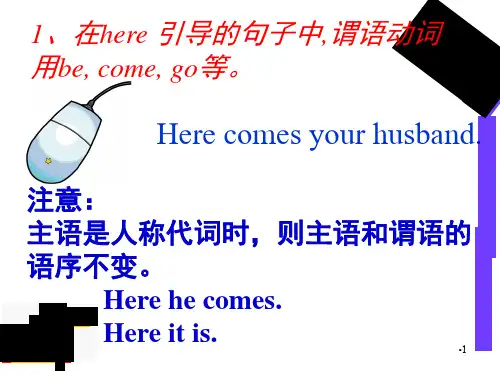
•15
6. 有些表示“感叹、祝愿”等语 气的句子,也可使用倒装结构
Eg.a. Isn‘t it cold! 天气真冷!
b. May both be happy! 祝你们两位幸福!
c. May God bless you. 愿上帝赐福于你。
d. Long live the king!
国王万岁!
•16
•9
3 、 so/such...that的so/such位于句首时 a.So loudly did the students read that people could hear them out in the street.
b.So small were the words that he could hardly see them.
______ for us.
• was the teacher ; did he care
B. was the teacher ; he cared
C. the teacher was ; did he care
D. the teacher was ; did he care
3. ___A___, he knows a lot of
C. I would believe
D. I believe
2. In __C____ and the students stood up.
A. the teacher comes
•6
• 2、为了强调only及其所修饰的
状语(通常是副词、介词短语或从 句),则将它们移到句首,句中的
主谓作部分倒装。如:
• Only then did we realize that the man was blind.
6. 有些表示“感叹、祝愿”等语 气的句子,也可使用倒装结构
Eg.a. Isn‘t it cold! 天气真冷!
b. May both be happy! 祝你们两位幸福!
c. May God bless you. 愿上帝赐福于你。
d. Long live the king!
国王万岁!
•16
•9
3 、 so/such...that的so/such位于句首时 a.So loudly did the students read that people could hear them out in the street.
b.So small were the words that he could hardly see them.
______ for us.
• was the teacher ; did he care
B. was the teacher ; he cared
C. the teacher was ; did he care
D. the teacher was ; did he care
3. ___A___, he knows a lot of
C. I would believe
D. I believe
2. In __C____ and the students stood up.
A. the teacher comes
•6
• 2、为了强调only及其所修饰的
状语(通常是副词、介词短语或从 句),则将它们移到句首,句中的
主谓作部分倒装。如:
• Only then did we realize that the man was blind.
倒装句详解ppt课件
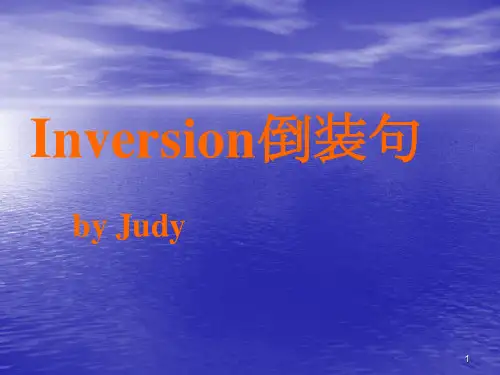
the table. (be) (2) There _l_iv_e_d__ a family of five in the village
five years ago.(live)
2、有时为了突出或强调主语,可用“表语+系动词+
主语”的完全倒装结构。
(3) ________ are the days when teachers were looked
Here you are ! Out they went.
辨 1.Here you are.
1'
别 2.There comes she.
正 误
3.In came the teacher .
4.In came he.
There ________. And here ________. 2'
A. goes the phone; she comes
__b_u__t _a_l_s_o__m__a_k_e_s__u_s__r_e_la__x_e_d_.___________________
归纳:英语的正常语序是“_主_语_ + _谓_语_”。 即主语在_前_,
谓语在_后_。 有时由于句子结构的需要或表示强调,就要采用
_倒_装_形式。将谓语动词完全移到主语之前称为_全_部_倒装;
Inversion倒装句
by Judy
1
Read, change the order and discover the rule
1' 1. Out rushed the children.T_h__e_c__h_i_ld_r_e_n__r_u_s_h__ce_od_m_op_u_let_.t_e_
3. _A_t_t_h_e_f_o_o_t_o_f_t_h_e__h_il_l _s_ta_n_d__s (坐落于山脚下)
five years ago.(live)
2、有时为了突出或强调主语,可用“表语+系动词+
主语”的完全倒装结构。
(3) ________ are the days when teachers were looked
Here you are ! Out they went.
辨 1.Here you are.
1'
别 2.There comes she.
正 误
3.In came the teacher .
4.In came he.
There ________. And here ________. 2'
A. goes the phone; she comes
__b_u__t _a_l_s_o__m__a_k_e_s__u_s__r_e_la__x_e_d_.___________________
归纳:英语的正常语序是“_主_语_ + _谓_语_”。 即主语在_前_,
谓语在_后_。 有时由于句子结构的需要或表示强调,就要采用
_倒_装_形式。将谓语动词完全移到主语之前称为_全_部_倒装;
Inversion倒装句
by Judy
1
Read, change the order and discover the rule
1' 1. Out rushed the children.T_h__e_c__h_i_ld_r_e_n__r_u_s_h__ce_od_m_op_u_let_.t_e_
3. _A_t_t_h_e_f_o_o_t_o_f_t_h_e__h_il_l _s_ta_n_d__s (坐落于山脚下)
初中英语语法课件-倒装句

初中英语语法 倒装句
倒装句
英语句子的基本语序是比较固定的,一般主语在前,谓语 在后。但有时因为语法结构的要求或由于修辞的要求,往 往要改变句子的自然语序,把一些本应置于主语之后的成 分提前,我们称这种语序为倒装语序。
倒装语序又分为全部(完全)倒装和部分倒装。
英语倒装句分为两种:
1. 整个谓语在前的句子,叫完全句首,表示前面否定的内容也适用于另一 个人(或物),构成“neither/nor+be动词/助动词/情态动词+主语” 结构时,用部分倒装。
—Mary didn't go to school yesterday. 玛丽昨天没去上学。 —Neither/Nor did I.我也没去。 注:be动词/助动词/情态动词在形式上与前一句的谓语保持一致,而其数 则由后一句的主语而定。
Here comes the car. 2. 如果只把助动词、情态动词或连系动词be放在主语之 前,这种语序称为部分倒装。
Only then did he realize that he was wrong.
倒装句
两点注意: 若有主从句,哪句倒装。 部分倒装还是完全倒装。
(一)全部(完全)倒装 如果谓语动词全部放在主语之前,这种语序称为完全倒 装。 1.表示方位的副词out,up,down,in,away置于句首 时,句子要全部倒装。
2023年8月27日星期日
7. 以not until ,no sooner …than , hardly …when ,not only …but also 所引导的状语放在句首时,需要部分倒装。
Not until 10’clock the will library open . No sooner had I gone out than he came to see me . Hardly had the train arrived when I ran to meet my friend. Not only does she speak English but also she follows the British way of life .
倒装句
英语句子的基本语序是比较固定的,一般主语在前,谓语 在后。但有时因为语法结构的要求或由于修辞的要求,往 往要改变句子的自然语序,把一些本应置于主语之后的成 分提前,我们称这种语序为倒装语序。
倒装语序又分为全部(完全)倒装和部分倒装。
英语倒装句分为两种:
1. 整个谓语在前的句子,叫完全句首,表示前面否定的内容也适用于另一 个人(或物),构成“neither/nor+be动词/助动词/情态动词+主语” 结构时,用部分倒装。
—Mary didn't go to school yesterday. 玛丽昨天没去上学。 —Neither/Nor did I.我也没去。 注:be动词/助动词/情态动词在形式上与前一句的谓语保持一致,而其数 则由后一句的主语而定。
Here comes the car. 2. 如果只把助动词、情态动词或连系动词be放在主语之 前,这种语序称为部分倒装。
Only then did he realize that he was wrong.
倒装句
两点注意: 若有主从句,哪句倒装。 部分倒装还是完全倒装。
(一)全部(完全)倒装 如果谓语动词全部放在主语之前,这种语序称为完全倒 装。 1.表示方位的副词out,up,down,in,away置于句首 时,句子要全部倒装。
2023年8月27日星期日
7. 以not until ,no sooner …than , hardly …when ,not only …but also 所引导的状语放在句首时,需要部分倒装。
Not until 10’clock the will library open . No sooner had I gone out than he came to see me . Hardly had the train arrived when I ran to meet my friend. Not only does she speak English but also she follows the British way of life .
初中英语英语倒装句PPT(共30张PPT)
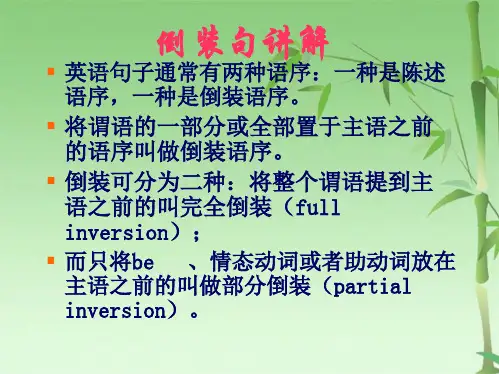
(3).当表示地点的介词词组(如on the wall, under the tree, in front of the house, in the middle of the room等)在句首时。
At the foot of the hill lies a beautiful lake. The soldiers ran to the building, on the top of which
flew a flag.
East of the lake lie two towns. Under the tree was lying a wounded soldier.
5) Near the church ________ cottage.
A. was such an old
B. had a so old
6. 在以often, well, many a time, now and again 等 方式或频度副词(短语)开头的句子中,要用部分倒
装结构。如:
Many a time has John given me good advice. Often have we made that test.
12) Many a time ________ swimming alone.
before?
—No, _____ anything like that before.
A. I never have seen B. never I have seen
C. never have I seen D. I have seen
3) She is not fond of cooking, ____ I.
6) The doctor told Charlie to breathe deeply and ____.
初中英语语法系列倒装句PPT课件
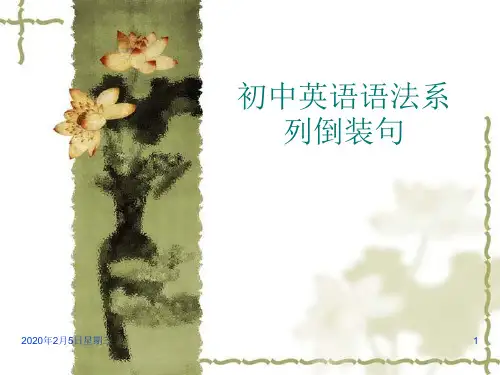
C. Nor is my wife
D. My wife hasn’t, too.
6.“Do you know Jim quarreled with his brother?” “I don’t know, ________.”
A. nor don’t I care
B. nor do I care
C. I don’t’ care neither
2020年2月5日星期三
2
Inversion(倒装句)
必须弄清的两点: ①若有主从句,哪句倒装。 ②部分倒装还是完全倒装。
2020年2月5日星期三
3
一、表示方位和时间的副词位于句首时(now ,then here ,there,out ,in ,up,down ,away ,back, off,on ), 句子全部 倒装。
A.did he realized C2.0h20a年d2月h5e日r星e期a三lized
B.he realized
D.he didn’t realize
15
5.I’ve not been to Shanghai. _________.
A. Neither has my wife
B. Neither hasn’t my wife
. 10.——David has made great progress recently.
——_________, and _________.
A. So he has; so you have B. So he has; so have you
C. So has he; so have you D. So has he; so you have
B. the teacher himself is; are all his students . C. is the teacher himself; are all his students
倒装句讲解精品PPT课件全文
❖ 6. Especially popular were his Sunday evening dinners, usually followed by musical performances.
❖ 7. Only in recent years have women begun to catch up with men in this area.
2)当这些词作形容词修饰主语时且置句首 时,句子不倒装。 Little work was done yesterday.
5.Neither..nor连接的两个句子都要倒装; not only…but also连接的两个句子时, not only后面的句子要倒装, but also不倒装
1)Neither has he called on her, nor will he do so. 2)Not only shall we learn from books,
No sooner had they entered the house than it began to rain.
注意
1)当上述单词不提前时,则不倒装。 I seldom read newspaper before. He had hardly finished his homework when the light went out.
一、完全倒装
1. 在there, here 引导的句子中,谓语是 be, exist, live,lie 等表示状态的不及 物动词。
There is nobody in the classroom. There seems something wrong with my radio. There stands a temple on the top of the mountain.
❖ 7. Only in recent years have women begun to catch up with men in this area.
2)当这些词作形容词修饰主语时且置句首 时,句子不倒装。 Little work was done yesterday.
5.Neither..nor连接的两个句子都要倒装; not only…but also连接的两个句子时, not only后面的句子要倒装, but also不倒装
1)Neither has he called on her, nor will he do so. 2)Not only shall we learn from books,
No sooner had they entered the house than it began to rain.
注意
1)当上述单词不提前时,则不倒装。 I seldom read newspaper before. He had hardly finished his homework when the light went out.
一、完全倒装
1. 在there, here 引导的句子中,谓语是 be, exist, live,lie 等表示状态的不及 物动词。
There is nobody in the classroom. There seems something wrong with my radio. There stands a temple on the top of the mountain.
《倒装句》PPT课件
英语中常见的倒装句有下列一些情况:
一、在疑问句中用倒装
Do you like English?
You aren’t interested in this film, are you?
What do you like best?
2021
2
二、在there be/live/lie句型中,用全部倒装 There are some books on the desk. There lived an emperor many years ago.
So angry was he that he couldn’t say a word. To such a degree was he excited that he couldn’t go to sleep that night. 若so/such 修饰主语时,不用倒装. So few people came to his birthday party that he felt disappointed. Such a brave man is always admired.
2021
15
17. The more…,the more…
The harder you study, the greater progress you will make.
The more exercise you take, the more good it will do you.
18.几个特殊让步状语从句: “无论” Be a man ever so clever, he knows nothing if he doesn’t learn.
Often did I remind him not to do that. Many a time has he made the same mistake.
倒装句(34张PPT)初中英语专项复习课件
At the foot of the hill lies a beautiful lake. Inside the box is a cat.
介词短语 + 谓语 + 主语
注意: 主谓保持一致,(stand) Under the tree__s_t_an_d_s_ a boy. Under the tree__s_ta_n_d__ two boys.
Nowhere are we going at the weekend. •2. He did not make a single mistake.
Not a single mistake did he make. •3. We often warned them not to do so.
Often did we warn them not to do so.
•2. He had hardly fallen asleep when a knock at the door awaked her. Hardly had he fallen asleep when a knock at the door awaked her.
4.not …until…
位于句首
Exercises:
•I did not begin to do my homework until my mother came back.
Not until my mother came back did I begin to do my homework.
5) Not only…but also…连接两个句子时,部分倒装
2. _______ in the past, at the moment it is a favorite choice for
介词短语 + 谓语 + 主语
注意: 主谓保持一致,(stand) Under the tree__s_t_an_d_s_ a boy. Under the tree__s_ta_n_d__ two boys.
Nowhere are we going at the weekend. •2. He did not make a single mistake.
Not a single mistake did he make. •3. We often warned them not to do so.
Often did we warn them not to do so.
•2. He had hardly fallen asleep when a knock at the door awaked her. Hardly had he fallen asleep when a knock at the door awaked her.
4.not …until…
位于句首
Exercises:
•I did not begin to do my homework until my mother came back.
Not until my mother came back did I begin to do my homework.
5) Not only…but also…连接两个句子时,部分倒装
2. _______ in the past, at the moment it is a favorite choice for
倒装句课件完整版
Tips:
主语为代词时, 主谓语序不变。
Eg:Here it is.
In he comes.
Exercise:1,给你。 2,他们离开了。
2,There be 结构(There lie / exist / stand / live +主语+...)表状态,表存在。 Eg: There stood a desk against the wall.
Translate: 坐在地上的是一群年轻人。
【Tips】
在表语置于句首的这类倒装结构中,要注意其中的 谓语应与其后的主语保持一致,而不是与位于句首 的表语保持一致。 Compare:
In the box was a cat. 箱子里是一只猫。 In the box were some cats. 箱子里是一些猫。
→Not until all the fish died in the river did the villagers realize how serious the pollution was. (将until后面的全部内容提前) 【疑难剖析4】not until提前时,要用倒装,且必须将not until后面的全部内容提前,而不仅仅是not until这两 个词。
C.Stands there;under
D.There stands;at
There stands an ancient tower on the top of the mountain.
3. 表地点的介词词组位于句首, Eg:South of the city lies a big steel factory.
Exercise: 不但妈妈而且孩子们也生病啦。
【Problem3】 I had hardly got to the airport when the plane took off.
- 1、下载文档前请自行甄别文档内容的完整性,平台不提供额外的编辑、内容补充、找答案等附加服务。
- 2、"仅部分预览"的文档,不可在线预览部分如存在完整性等问题,可反馈申请退款(可完整预览的文档不适用该条件!)。
- 3、如文档侵犯您的权益,请联系客服反馈,我们会尽快为您处理(人工客服工作时间:9:00-18:30)。
虽然她很小,但她却能独自解出那道难题。 2)Child as/though he is, he is very brave. 尽管他是个孩子,但他却非常勇敢。 注意:如果从句中的表语是名词,其名词前
不加任何冠词。
二、几种常见的完全倒装结构
1.there be句型:有时该句型中也可用其他表示存 在意义的动词代替be。如:live,remain,come, stand,go,lie,exist等等。 1)There is a lamp and two cups on the table.桌上有一盏灯和两只杯子。 2)There used to be a shop around the corner. 拐角处过去有一家商店。 3)Once upon a time there lived six blind men in a village in India. 从前在印度的一个村子里住着六位盲人。
Only after you left did l find this bag. 只是在你离开以后我才发现这只提包。
2.含否定意义并修饰全句的词放在句首。 如:not,little, few , hardly, scarcely, no
more, no longer, in no way, never, seldom, not only, no sooner等等。如:
我对数学不感兴趣,他也同样。
注:当前面陈述句有两个以上不同类型的谓语动 词时,如be,do或can等等,或者既有肯定式又 有否定式时,如have和hasn't等等,不能单独使 用so或者neither/nor,而应换用另外的句型结构:
A:So it is with…; B:It is the same with…。见例句: 1)—I like chicken, but I don't like fish. —— 我喜欢吃鸡肉,但不喜欢吃鱼。
4.Neither,nor或no more放在句首,作 “也不”讲,跟在一个否定句之后,表示前 面所述内容也适用于另一人或物。例如:
1)My teacher didn‘t agree with him.Nor did I.
老师不同意他的意见,我也不同意。
2)I‘m not interested in maths.Neither is he.
1)l like travelling.So does he. 我喜欢旅行,他也喜欢。
2)Her father is a doctor.So is her mother.她父亲是位医生,她母亲也是。
3)He has been to Beijing twice.So have I.
他去过北京两次,我也去过两次。
1)Seldom do I go to work by bus. 我很少乘公共汽车上班。
2)Never shall I forget it. 我永远不 会忘记这件事。
3)No sooner had I got home than it began to rain. 我刚一到家,天就开始 下雨。
3.So放在句首,跟在一个肯定句之后, 表示前面所述内容也适用于另一人或物。 如:
2)May you sucthe people's Republic of
China! 中华人民共和国万岁!
8.由as /though引导的表示“虽然”,“尽管” 的让步状语从句用倒装语序时,把从句的表语 或状语等放在as/though的前面。例如:
1) Young as/though she was, she could work out that problem alone.
英语中的倒装句
英语最基本的语序是主语在前,谓语 动词在后。但有时由于句子结构的需 要或表示强调,就要采用倒装形式。 将谓语动词完全移到主语之前称为完 全倒装,只将助动词或情态动词放到 主语之前称为部分倒装。
一、几种常见的部分倒装结构: 1.Only+状语或者状语从句放在
句首。如:
Only in this way can we improve our English. 只有这样,我们才能提高英语水平。
他那么努力工作,抽不出时间去旅行。
6.虚拟条件句省略if时,将were,should或 had移到主语之前。如:
1)Should it rain,all the crops would be saved.
若是下雨的话,庄稼就都得救了。
2)Were my teacher here,he would give some good advice.
2.句子的开头是here,there ,now, then等副词。如:
1)Here are some interesting stories for you to read 这儿有些有趣的故事给你读。
1) So badly was he injured in the
accident that he was sent to the hospital for treatment.
在这次事故中他伤得很重,被送进医 院治疗。
2)So hard does he work that he has no time to spare for travelling.
—So it is with me. ——我也如此。 2)Tom is an American,but lives in China, it is the same with Jack.
汤姆是美国人,但他住在中国。杰克也如此。
5.副词often,短语many a time,或者 so修饰形容词或副词、位于句首时。例如:
我的老师如果在这儿,他会提些好建议的。
3)Hadn't it been for his help,we wouldn't have finished the work in time.
若非有他帮忙,我们就不能及时完成工作。
7.以May…或Long live…开头的某些表 示祝愿的用语。如:
1)May God bless you. 愿上帝保佑你!
不加任何冠词。
二、几种常见的完全倒装结构
1.there be句型:有时该句型中也可用其他表示存 在意义的动词代替be。如:live,remain,come, stand,go,lie,exist等等。 1)There is a lamp and two cups on the table.桌上有一盏灯和两只杯子。 2)There used to be a shop around the corner. 拐角处过去有一家商店。 3)Once upon a time there lived six blind men in a village in India. 从前在印度的一个村子里住着六位盲人。
Only after you left did l find this bag. 只是在你离开以后我才发现这只提包。
2.含否定意义并修饰全句的词放在句首。 如:not,little, few , hardly, scarcely, no
more, no longer, in no way, never, seldom, not only, no sooner等等。如:
我对数学不感兴趣,他也同样。
注:当前面陈述句有两个以上不同类型的谓语动 词时,如be,do或can等等,或者既有肯定式又 有否定式时,如have和hasn't等等,不能单独使 用so或者neither/nor,而应换用另外的句型结构:
A:So it is with…; B:It is the same with…。见例句: 1)—I like chicken, but I don't like fish. —— 我喜欢吃鸡肉,但不喜欢吃鱼。
4.Neither,nor或no more放在句首,作 “也不”讲,跟在一个否定句之后,表示前 面所述内容也适用于另一人或物。例如:
1)My teacher didn‘t agree with him.Nor did I.
老师不同意他的意见,我也不同意。
2)I‘m not interested in maths.Neither is he.
1)l like travelling.So does he. 我喜欢旅行,他也喜欢。
2)Her father is a doctor.So is her mother.她父亲是位医生,她母亲也是。
3)He has been to Beijing twice.So have I.
他去过北京两次,我也去过两次。
1)Seldom do I go to work by bus. 我很少乘公共汽车上班。
2)Never shall I forget it. 我永远不 会忘记这件事。
3)No sooner had I got home than it began to rain. 我刚一到家,天就开始 下雨。
3.So放在句首,跟在一个肯定句之后, 表示前面所述内容也适用于另一人或物。 如:
2)May you sucthe people's Republic of
China! 中华人民共和国万岁!
8.由as /though引导的表示“虽然”,“尽管” 的让步状语从句用倒装语序时,把从句的表语 或状语等放在as/though的前面。例如:
1) Young as/though she was, she could work out that problem alone.
英语中的倒装句
英语最基本的语序是主语在前,谓语 动词在后。但有时由于句子结构的需 要或表示强调,就要采用倒装形式。 将谓语动词完全移到主语之前称为完 全倒装,只将助动词或情态动词放到 主语之前称为部分倒装。
一、几种常见的部分倒装结构: 1.Only+状语或者状语从句放在
句首。如:
Only in this way can we improve our English. 只有这样,我们才能提高英语水平。
他那么努力工作,抽不出时间去旅行。
6.虚拟条件句省略if时,将were,should或 had移到主语之前。如:
1)Should it rain,all the crops would be saved.
若是下雨的话,庄稼就都得救了。
2)Were my teacher here,he would give some good advice.
2.句子的开头是here,there ,now, then等副词。如:
1)Here are some interesting stories for you to read 这儿有些有趣的故事给你读。
1) So badly was he injured in the
accident that he was sent to the hospital for treatment.
在这次事故中他伤得很重,被送进医 院治疗。
2)So hard does he work that he has no time to spare for travelling.
—So it is with me. ——我也如此。 2)Tom is an American,but lives in China, it is the same with Jack.
汤姆是美国人,但他住在中国。杰克也如此。
5.副词often,短语many a time,或者 so修饰形容词或副词、位于句首时。例如:
我的老师如果在这儿,他会提些好建议的。
3)Hadn't it been for his help,we wouldn't have finished the work in time.
若非有他帮忙,我们就不能及时完成工作。
7.以May…或Long live…开头的某些表 示祝愿的用语。如:
1)May God bless you. 愿上帝保佑你!
